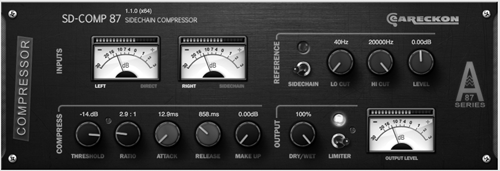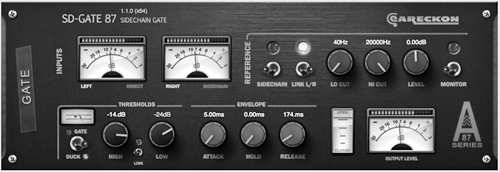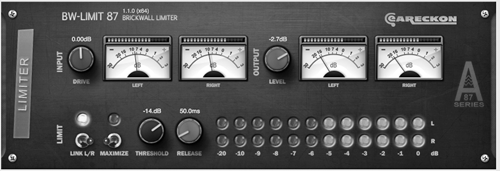LET ME SHOW YOU THEM
We’ll start with the compressor. The SD-COMP 87 is a stereo compressor with a sidechain input, making it easy to create a de-esser or even have it compress a music bed under a VO. Engaging the sidechain is as simple as flipping the toggle switch in the Reference section on the upper right, and both low and high cut filters are included to shape the reference (you may be more familiar with the term “key”). The SD-COMP control range is standard — Threshold from 0 dB to -90 dB; Ratios from 1:1 up to 10:1 (which is limiting); Attack as short as half a millisecond and Release up to 2.5 seconds. In addition, a brickwall Limiter will clamp the compressor’s output at 0 dB, period, and in a nod to the widespread use of parallel compression, it features a Mix control. I found the latter most useful to get a voice track to sit properly with a bed; at about 40% Wet there was enough compression to carry the advertising message without killing the natural dynamics, and I didn’t have to bus it to another track.

If the SD-COMP 87 has a “sound’ it can be said to be somewhat 1176-ish (as opposed to a softer, slower LA-2A character). Given its wicked-fast attack time and slightly aggressive character, this compressor definitely comes off sounding opto rather than tube. But these have more to do with the response, rather than the static character, of which there is little. It’s lots of very clean-sounding compression, although it will gladly produce pumping if you push it. The sidechain function is an added bonus, as is the built-in limiter and the Mix function.
OPEN THE GATE
While we’re in the land of dynamics, it’s worthwhile to look at the SD-GATE 87, which performs either gating or ducking depending upon the setting of the toggle switch in the lower left. It is equipped with a sidechain input, as well as two adjustable thresholds that define the amplitude areas that will be effected. These can be linked such that they change together, or unlinked which allows setting them independently.

When the SD-GATE 87 is switched to Gate mode, then sounds whose amplitude drops below the lower threshold cause the Gate’s output to be muted, until the point at which the sound’s amplitude exceeds the upper threshold. When switched to Duck mode, the opposite happens when the two thresholds are linked; sounds are allowed to pass while below the upper threshold. When they exceed the upper, the gate closes until the level drops below the lower threshold. Unlinking the thresholds creates some interesting effects when in Duck mode.
Incidentally, having two separate thresholds on an audio gate is not unique on either hardware or software implementations of gating, but it is unusual especially on a plug-in at SD-GATE 87’s price point. When a signal crosses the threshold regularly, it can cause a gate to “chatter” as it turns on and off quickly. Having a second threshold introduces hysteresis and smoothes out the gate’s performance. It’s a nice touch.
The envelope controls, consisting of Attack, Hold, and Release, are properly calibrated and have sufficient range to make them useful. Using a mouse to adjust them can be a bit fiddly; fortunately you can type in a specific value on any control. The sidechain section comes with filters and gain, and the whole business looks and feels right. After using the bare-bones gate plugs included with most editors, the SD-GATE 87 looks like the bridge of the Enterprise. There are more than enough parameters available to get what you want, and have a good-sounding result. After all, all you want is to turn some soft stuff down, right?
MAXIMIZING LIMITS
The BW-LIMIT 87 is a dedicated brickwall limiter which will also process your sound to “maximize” it. Again, eaReckon provides some nice surprises in what is usually a simple processor. The best of these is under a switch labeled Maximize which, when engaged, automatically adjusts the gain of the limiter to raise the volume of the loudest peaks up to the level set by the Output Level knob, while still preventing those peaks from exceeding the Level setting.

The unit is a full stereo processor, but there’s a Link L/R switch which allows channels to be processed separately but with the same settings. And if that confused you don’t feel bad; it did me as well. It decouples the two processors such that they will limit each channel separately, which of course will totally screw up any sort of phase coherency across the stereo bus. Maybe it’s one of those functions that exists just because they can make it exist. On the other hand, the meters are big and hard to miss in use, a bonus compared to others I’ve used.
Also notable is that although there’s a Release setting for the Limiting, there is no Attack knob. eaReckon decided that because BW-LIMIT 87 is a brickwall limiter, they would forego the Attack knob in favor of a preset Attack time that includes look-ahead to optimize the “wall” portion of the brickwall for maximum rise time without distortion.
A good limiter is a tool I use on almost every session, including printing the limiter on a voiceover tracks when the talent is dynamic (think video games). The BW-LIMIT 87 is a winner.

